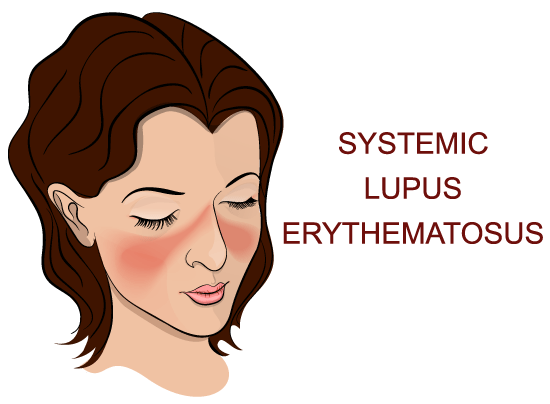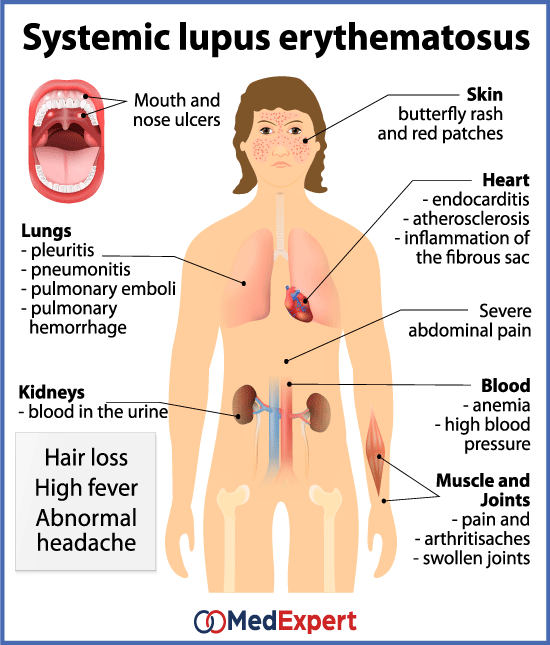Systemic Lupus Erythematosus
The job of the immune system is to fight off dangerous infections and bacteria in order to keep the body healthy. An autoimmune disease however, is when the immune system attacks the body because it has confused the body for something foreign and dangerous. One such autoimmune disorder is Systemic Lupus Erythematosus (SLE).

The term lupus has been used to identify a number of immune diseases are similar in their presentation, but SLE is the most common type of lupus. When people say the word lupus they are often referring to SLE.
SLE is a chronic disease that can have alternating phases of worsening and easing symptoms. Most people with SLE are able to live a normal life with the right treatment.
According to the Lupus Foundation of America, at least 1.5 million Americans are living with diagnosed lupus, but believe that the number of people who actually have the condition is considerably higher.
What causes SYSTEMIC LUPUS ERYTHEMATOSUS?
The cause of autoimmune diseases is largely unknown.
SLE more commonly affects women rather than men and can occur at any age. However, it tends to appears most often in people between the ages of 15 and 44 and affects African Americans and Asians more often than people from other races.
It should be noted that certain drugs may also cause SLE.
WHAT ARE THE SYMPTOMS OF SYSTEMIC LUPUS ERYTHEMATOSUS?
Symptoms can vary and can change over time. In most cases these symptoms include:
- Joint pain
- Joint swelling
- Severe fatigue
- Hair loss
- Headaches
- A rash on the cheeks and nose, which is called a “butterfly rash”
- Anemia
- Blood-clotting issues
- Fingers turning white or blue and tingling when cold (Raynaud’s phenomenon)
Other symptoms largely depend on which part of the body the disease is attacking, such as the heart, skin or digestive tract.
Diagnosis of lupus is tricky as many of its symptoms feature in many other diseases. If you have any of these symptoms, consult your doctor if you have any of these symptoms.

TREATMENT OPTIONS AVAILABLE SYSTEMIC LUPUS ERYTHEMATOSUS
Treatment for lupus depends on your signs and symptoms. Determining whether your signs and symptoms should be treated requires a careful consideration. As your signs and symptoms flare and subside, you and your doctor may find that you’ll need to alter medications or their dosages. The medications most commonly used to control lupus include:
- Nonsteroidal anti-inflammatory drugs (NSAIDs): Treating pain, swelling and fever associated with lupus may be done using over-the-counter NSAIDs, such as naproxen sodium (Aleve) and ibuprofen (Advil, Motrin IB, others). Stronger NSAIDs are prescribed if necessary. Side effects of NSAIDs can include stomach bleeding and the increased development of heart and kidney problems.
- Antimalarial drugs: Hydroxychloroquine (Plaquenil) and other drugs that are often used to treat malaria can also be used to control lupus. Side effects can include stomach discomfort and in rare cases, damage to the retina of the eye.
- Corticosteroids: Corticosteroids such as Prednisone can counter the inflammation caused by lupus, however they come with a cost. long-term side effects such as weight gain, easy bruising, high blood pressure, thinning bones (osteoporosis), diabetes and increased risk of infection can also occur. The risk of side effects occurring grows with higher doses and longer term therapy.
- Drugs: Drugs such as azathioprine (Imuran, Azasan), mycophenolate (CellCept), leflunomide (Arava) and methotrexate (Trexall) actively suppress the immune system to stop it from attacking the body. There are potential side effects though, including the increased risk of infection, liver damage, decreased fertility and an increased risk of developing cancer. A newer medication, belimumab (Benlysta), is known to reduce lupus symptoms in some people. Side effects include nausea, diarrhea and fever.
DIAGNOSING SYSTEMIC LUPUS ERYTHEMATOSUS
In order to be diagnosed with lupus, you must have 4 out of the 11 common signs associated with the disease. Nearly all people with lupus have a positive test for antinuclear antibody (ANA), however, having a positive ANA alone does not prove that you have lupus.
In order for your doctor to diagnose you, a physical examination to check for typical signs and symptoms of lupus will need to be performed. The symptoms your doctor will be looking for will include:
- Sun sensitivity rashes, such as a butterfly rash or malar
- Mucous membrane ulcers, which may occur in the nose or mouth (or both)
- Arthritis – tenderness or swelling of the small joints of the hands wrists, knees and feet
- Hair thinning/hair loss
- Signs that your heart or lungs are affected, such as murmurs, rubs, or irregular heartbeats
No one single test is diagnostic for SLE, however screenings that can help your doctor make an informed diagnosis include:
- Blood tests – complete blood count and antibody tests
- A urinalysis
- A chest X-ray


